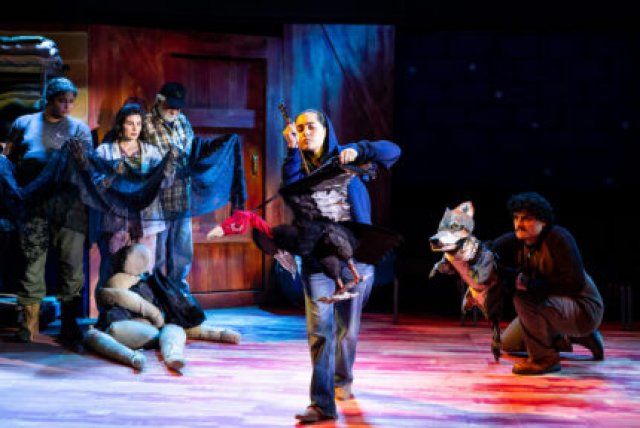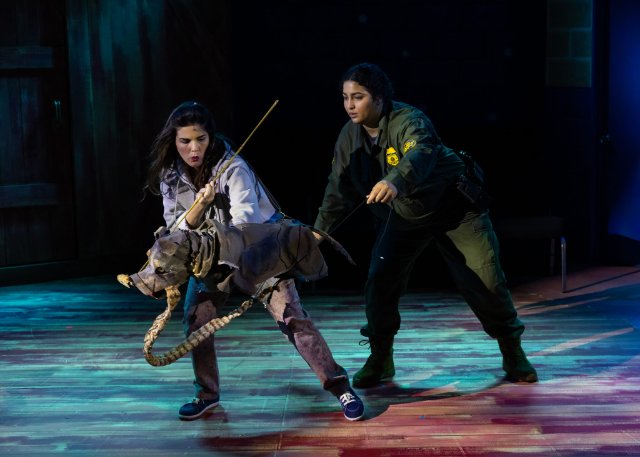Refuge
Rolling World Premiere at Theatre Lab in South Florida
By: Aaron Krause - Apr 12, 2023
“I may be a wolf but I’m afraid all the time,” the wild animal tells us in the compelling new play, Refuge. He lives in "a state of fear even in my dreams. I have no pack to keep me safe. They left me behind a long time ago for being too small. I could be killed at any moment by a snake, a human, the desert, the brush, and no one would care.”
Perhaps the above gives you an idea of what life is like for migrants. They make a dangerous trek through harsh terrain, on their way to what they hope is a better life. Indeed, during their journey, they are like the abandoned, malnourished wolf – alone, hungry, and scared, having to fend for themselves in a harsh, unforgiving environment.
Refuge, a play about people (and animals), but not politics, is onstage in a strong professional production through April 23 at Theatre Lab in Boca Raton. The production is part of the piece’s rolling world premiere. This 90-minute, intermission-less play with music and puppets by Satya Jnani Chávez and Andrew Rosendorf previously ran at theater companies in Colorado and Missouri to begin its theatrical life.
Refuge, an eloquent, gripping, and theatrical piece with symbolism and humor, does not propose solutions to the migration crisis, nor does it take sides in the immigration issue. Also, the writers do not stuff the play with facts and statistics. With that said, it wouldn’t hurt to view a few statistics on a projection screen before the show.
Mostly, the play’s authors humanize the immigration issue by following the journey of a Honduran teenage girl as she tries to enter the U.S.
Theatre Lab, the nonprofit, professional theater company of Florida Atlantic University, dedicated to developing new work, has assembled a talented cast and company to tell this relatable story. Music and magical realism heighten the characters’ emotions, strengthen the piece’s symbolism, reinforce the moods of scenes, and enhance the piece’s drama.
Refuge takes place 70 miles north of the U.S./Mexico border near the fictional town of Desolation, Texas.
An unnamed teenage girl from Honduras is trying to find her mother in America. While trekking through the desert, she discovers a woman and baby who died of dehydration. After a brutal sun beat down on them for days, their bodies became partly mummified. Of course, the girl, scared and sad as she may be, will have to continue on her journey to avoid a similar fate.
While on her way, the girl encounters animals, a ranch owner who routinely sees migrants, and a U.S. border patrol agent searching for them.
Will the girl reach her mother in America before a border patrol agent sends her back to her home country? Also, what will happen to the wolf and a dog named Steph? While the wolf lives malnourished in the desert, Steph, Frank’s ranch dog, lives safely, and well-fed on the ranch. The animals are in conflict with each other, representing the battle between the girl and Frank.
When it comes to audiences experiencing the play, Refuge requires patience, close attention, imagination, and the suspension of disbelief.
For starters, chunks of the play are in Spanish without supertitles. Therefore, non-Spanish-speaking patrons will need to pay close attention to the actors’ gestures, facial expressions, and the emotion escaping their voices (they are all vivid and believable in Theatre Lab’s production).
You may ask why Theatre Lab doesn’t include supertitles. One possible answer is that by presenting parts of the play in Spanish only, the theater artists force us to experience what life must be like for migrants such as the unnamed girl. She doesn’t speak or understand English, so she must somehow discern what others are trying to tell her.
On another note, in Refuge, the playwrights use magical realism. In live theater, this typically refers to the coexistence of the real and fantastical, the natural and the supernatural. Further, in magical realism, people do not question elements of fantasy. So, when the wolf and dog talk during Refuge, which is otherwise a realistic play, the other characters respond as though nothing is out of the ordinary.
By having the animals speak, the playwrights reinforce the notion that during their often-harrowing journeys, migrants essentially live in the wild, and must survive like wild animals in a dog-eat-dog environment.
“They’re just trying to survive – like me,” the wolf says, referring to migrants.
In addition, hearing the animals speak reinforces the notion that each of us possesses human and beast-like qualities.
“Life is inherently violent,” the wolf tells us. “Harmony, civility, is what you have to work at.”
However, it can be hard for people such as Frank to work at strengthening such qualities. Indeed, immigrants who cross the border often arrive on the man’s ranch by design. Frank’s late daughter, Sarah, offered food, water, and other types of help to migrants passing near their house. For his part, Frank has grown resentful toward the migrants. Frankly, he views them as trespassers. But the sight of the unnamed girl passed out on his property reminds him of his late daughter. Therefore, he decides to help this migrant.
The playwrights also humanize Martina. She is a Mexican-American U.S. Border Patrol agent on the lookout for trespassing migrants. The sight of the dead mummified woman and her baby stuns Martina, who is eight-and-a-half months pregnant.
When Martina pauses to consider what is happening all around her, she wonders, “what kind of future lies for my daughter?”
Let the blunt-speaking, wise wolf explain.
“We are all illegal here,” the beast says. “Borders existing everywhere – and nowhere. Always on the wrong side – to someone.”
In addition to co-writing Refuge, Chávez directs Theatre Lab’s production with intensity and sensitivity (Joanna Orrego Castillo is the assistant director). Under their guidance, scenes of conflict are intense, yet believable, and the characters’ emotions seem authentic.
In addition to directing the production, Chávez is the music director. Scenes featuring spoken words segue seamlessly into moments of song, and vice versa.
Most of the instrumental music comes from a guitar, which Krystal Millie Valdes plays flawlessly. Also, Valdes sings pleasantly and expressively, as do other performers. The songs, some haunting, some somber, reinforce the moods and emotions in scenes. Appropriately, the actors hold a black sheet as a symbol of mourning during one song. The performers sway with feeling and cross themselves.
As actors, the cast members create believable, identifiable characters with distinct personalities.
With wide, dark eyes and an intensity befitting his character, Michael Gioia imbues the rancher with a no-nonsense demeanor, vigilance, and suspicion. These traits suggest that he is on the look-out for migrants trespassing on his property. But Gioia, who at times acts appropriately gruff, also conveys his character’s softer side during appropriate times.
Meanwhile, as border patrol agent Martina, Melinette Pallares is confident and alert, while at other times she is disgusted and vulnerable. Clearly, she is stunned and upset when she discovers the dead woman and her baby.
“Sorry (God) didn’t give you both a miracle, watch over you,” Martina says with believable sorrow. “Your home doesn’t want you, we don’t want you. Stuck nowhere in limbo, like my whole life in this country.”
As the girl, Nathalie Andrade lends her character a breathless desperation, exasperation, and fear. Even though the character doesn’t speak English, we sense her emotions from the performer’s expressive voice and telling gestures.
Kevin Cruz, howling convincingly, imbues the wolf with wisdom and a hint of madness. However, the performer could better convey the animal’s desperation, fear, and exhaustion. To Cruz’s credit, he operates his puppet in sync with his own voice.
A palpable tension exists between Cruz’s wolf and Steph the dog, whom Gaby Tortoledo portrays with nervous energy. In addition, Tortoledo operates her puppet in sync with her own voice.
Other members of the ensemble deftly portray animals such as a diamondback rattlesnake, vultures, and a kangaroo rat.
Credit puppet designer John Shamburger for creating believable, sturdy-looking figures, while Dawn C. Shamburger designed the character-defining costumes.
Also, behind the scenes, Alyiece Morreto-Watkins and Timothy S. Dickey created a spacious, detailed, and realistic-looking set. It resembles the exterior of a barn. The set extends out into the audience seating area, reinforcing the relevance of the play to our times.
In Theatre Lab's intimate playing space, audience members sit on either side of the stage, in between the actors. It is as though the characters are trapped in between the two groups of audience members, forced to deal with their unenviable and perhaps even dangerous circumstances.
Lighting designer Jose Santiago illuminates the set and actors sometimes dimly, and during other moments with harsh lighting. The dimly-lit scenes take place at night. Meanwhile, intense lighting represents a bright sun, and provides emphasis and focus.
At some shows, the director or somebody else may invite us to sit back, relax, and enjoy the show. But before a performance of a play such as Refuge, it is more appropriate to invite an audience to sit forward, engage, and then take action. Great theater can move us to do just that when it comes to vital issues that are not going away anytime soon.
Refuge runs through April 23 at Theatre Lab, 777 Glades Road on Florida Atlantic University’s Boca Raton campus. Performances are at 7:30 p.m. Thursday-Saturday, and 3 p.m. Sunday. Tickets range from $35-$45. Call (561) 297-6124 or visit www.fau.edu/artsandletters/theatrelab.


